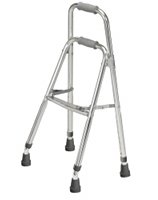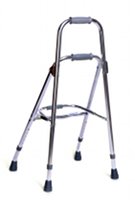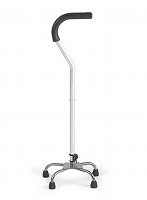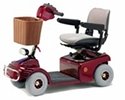
Hemi Walker
Product Guide and Recommendations
A hemi walker is a specialized mobility aid for elderly who would benefit from the support of a folding walker but cannot hold one with both hands.
This is commonly due to full or partial paralysis on one side of the body (hemiplegia) but can also be the result of a broken bone in the arm, wrist, hand or collarbone.
I have had elderly use one who broke their collarbone and could not use their regular walker. After everything was healed they went back to their old walker without any problems.
They provide more support than a quad cane and less than a folding walker.
They actually look quite similar to a folding walker (foldable, no wheels) but are held like a cane with one hand.
It is not too uncommon for elderly who have had a stroke start using a hemi walker and progress to a quad cane (and even a single point) after continued rehabilitation therapy.
Who Should Use?

Hemi walkers are designed for elderly who:
- Have difficulty using an arm, wrist or shoulder due to stroke, broken bone or other isues
- Need the support a folding walker provides but cannot safely use (due to the above)
- Have enough balance to safely use - if not they may want to consider using a folding walker with a forearm attachment or a wheelchair
- Have enough strength/endurance to walk with one safely
Who Should NOT Use?
They are not recommended for seniors who have significant balance, strength and endurance issues.
These seniors should probably be using a wheelchair, such as a light weight wheelchair.
They are also not designed for elderly who do not need this much support. They would be better suited to use a quad cane or wheeled walkers for elderly.
For information about other mobility products for the elderly.
Recommended Features

A good hemi walker will have the following features:
- Lightweight - Makes it easier to use as the senior will need to pick it up every two steps.
- Foldable - Makes it easier to transport in a car.
- Height adjustable - It's important to be able to adjust the walker to the senior's needs and height.
- Comfortable handle - More enjoyable to use.
- Sturdy/Stable - Make sure that all the legs touch the ground when resting on a level surface.
How to Fit
Similar to other mobility products for the elderly, the height of the handle should be at the same level as the senior's wrist when their standing tall and their arm is by their side.
How to measure:
- Make sure they are wearing their regular shoes
- Have the elderly stand next to a wall or chair for balance (may need a second person to assist them if you are concerned with their balance).
- With one of their arms at their side, measure from the ground to the crease of their wrist
- This gives you the approximate height of the handle - personal preference can move it up or down 1 inch
The goal is to have the senior stand tall while walking with a natural stride and not hunched over taking too big (or small) steps.
How to Use
It will take practice to get proficient at using. In the beginning it will feel like an extra big cane.
- Make sure the walker is locked in the open position
- Have someone close for balance support if needed
- Similar to using a cane, the senior's goal is to move the opposite leg together with the hemi walker
- In the beginning it is usually a three step process, walker, opposite leg and then other leg
- As they become more comfortable, it becomes a two step sequence: walker and opposite leg move together, and then the other leg - repeat
How Much Do They Cost?
A hemi walker costs $50-100 depending on features.
Other Types of Canes and Walkers

There are a number of different canes and walkers:
- Folding cane - A single point cane for seniors who only need a little support for balance.
- Quad cane - Is similar to a single point cane but with a larger base (usually with 4 points).
- Folding walker - A standard walker with no wheels.
- Rollator walker - 4 wheels, a bag/basket, a seat and hand brakes.
- 3 wheel walkers - 3 wheels, a bag/basket and hand brakes.
- Knee walker - An alternative to crutches for seniors who cannot put weight on a foot/leg due to a broke bone or post surgery.
Return to Mobility Products for the Elderly
Return to Caring for Aging Parents






New! Comments
Have your say about what you just read! Leave me a comment in the box below.